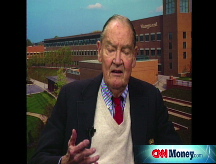Why saving is killing the economy
Saving more and cutting debt might sound like a good plan to deal with the recession. But if everyone does that, it'll only make matters worse.
NEW YORK (CNNMoney.com) -- It wasn't that long ago that many economists worried that Americans were saving too little.
Today, the growing concern is that Americans are starting to save too much.
It's not that the savings rate today is high by historic measures, or by comparisons to some other countries. But it has moved sharply higher in recent months -- at a time when what the economy needs most is for consumers to be spending more freely.
"In the long-term, it's best for Americans to save more. But right now, with the economy underwater, it's the worst time for that," said Rich Yamarone, director of economic research at Argus Research.
The savings rate, as calculated by the Commerce Department, hit 3.6% in December, or the equivalent of $36 for every $1,000 of after-tax income.
That's up from 0.8% in August, or only $8 of every $1,000 of income. And since the average income for Americans is flat to slightly down during the past few months, the only way the savings rate can rise is for spending to fall.
"That's a lot of spending that's not happening," said Mark Zandi, chief economist for Moody's Economy.com. He said the jump in the savings rate since last summer is "the difference between an economy that is growing and one that is struggling mightily."
The government calculates savings by totaling up after-tax income and subtracting spending. The remainder is considered savings by the government even if consumers are using the leftover money for investing or paying down debt instead of saving it in a bank.
In months when income spikes due to special circumstances -- such as May 2008, when most taxpayers got economic stimulus checks of between $600 to $1,200, and December 2004, when Microsoft paid investors a big one-time dividend -- that can cause a significant jump in the savings rate.
But excluding those months, the savings rate this past December was the highest since September 2001.
Until the economic upheaval of the past year, the savings rate was at historic lows, averaging only 0.5% from the start of 2005 through April 2008. The savings rate occasionally even fell below zero, indicating that Americans were dipping into savings to keep spending at a high level.
Keith Hembre, chief economist for First American Funds, said the low savings rate earlier this decade was due to consumers spending beyond their means for years.
And they could afford to do so as long as the stock market was rising and surging real estate prices allowed people to turn their homes into an ATM machine that consumers thought had a limitless supply of money.
But once the stock market and housing market bubbles burst, Hembre said consumers had no choice but to spend more modestly.
"I think we're at a secular shift here in terms of consumption and broader spending behavior," he said.
Some say the sudden rise in the savings rate since last summer is due primarily to Americans worried about their jobs and the economy. Others say it's a product of the drop in stock prices and 401(k) balances, which have prompted Americans to cut back on spending and replenish their retirement accounts.
In addition to the desire to save more, Americans are seeing their access to credit cut off, which is raising the savings rate as well. Plunging housing prices have made it difficult for many to tap home equity lines of credit, and lenders have also tightened standards for credit cards.
Figures from the Federal Reserve show that consumer debt fell for the first time on record in the third quarter. Since then, consumer borrowing has continued to decline.
To be sure, a high savings rate is not a bad thing for the economy. From the mid-1950's through the mid-1980's, the savings rate was in the 8% to 11% range.
Money that was saved in those decades helped fuel economic growth because much of the savings were invested in businesses, which in turn used the investments to make more products and hire more workers.
But economists say the real problem is the sudden rise in the savings rate.
"Saving is a good thing and paying debt is a good thing, but not overnight," said Zandi. "If we go from zero to 10% in a year or so, you'll have a severe downturn that can become self enforcing."
Yamarone added that the usual economic benefits tied with a higher savings right aren't evident now because consumers' "savings" aren't being put to use the way they normally would be. Banks, after all, are less willing to use deposits to make new loans.
"Consumers' cash might not be going into their mattress, but it's not going into the economy either. They're just going to stuff Vikram Pandit's mattress," he joked, referring to the CEO of Citigroup, one of the nation's largest banks. ![]()



